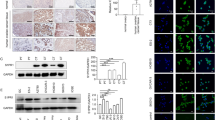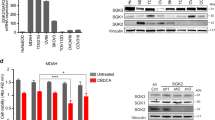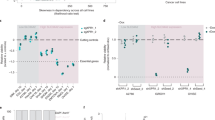Abstract
Dysregulated apoptosis plays a critical role in the development of a number of aberrant cellular processes, including tumorigenesis and chemoresistance. However, the mechanisms that govern the normal apoptotic program are not completely understood. Soluble guanylyl cyclase (sGC) and cyclic guanosine monophosphate (cGMP) promote mammalian cell viability via an unknown mechanism and p53 status is a key determinant of cell fate in human ovarian cancer cells. Whether an interaction exists between these two determinants of cell fate is unknown. We hypothesized that basal sGC activity reduces p53 content and attenuates p53-dependent apoptosis in human ovarian cancer cells. Suppression of sGC activity with the specific inhibitor 1H-[1,2,4]oxadiazolo[4,3-a]quinoxalin-1-one (ODQ) lowered cGMP content, and increased p53 protein content and induced apoptosis in three ovarian cancer cell lines, effects which were attenuated by the cGMP analog 8-Br-cGMP and by Atrial Natriuretic Factor, an activator of particulate guanylyl cyclase, which circumvent the inhibition of sGC. ODQ prolonged p53 half-life, induced phosphorylation of p53 on Ser15, and upregulated the p53-dependent gene products p21, murine double minute-2, and the proapoptotic, p53-responsive gene product Bax. ODQ activated caspase-3, and ODQ-induced apoptosis was inhibited by overexpression of X-linked inhibitor of apoptosis Protein. Pretreatment with the specific p53 inhibitor pifithrin or downregulation of p53 using a specific small inhibitory RNA significantly attenuated ODQ-induced apoptosis. Moreover, ODQ-induced upregulation of p21 and Bax and ODQ-induced apoptosis were significantly reduced in a p53 mutant cell line relative to the wild-type parental cell line. Thus, the current study establishes that basal sGC/cGMP activity regulates p53 protein stability, content, and function, possibly by altering p53 phosphorylation and stabilization, and promotes cell survival in part through regulation of caspase-3 and p53.
This is a preview of subscription content, access via your institution
Access options
Subscribe to this journal
Receive 50 print issues and online access
$259.00 per year
only $5.18 per issue
Buy this article
- Purchase on Springer Link
- Instant access to full article PDF
Prices may be subject to local taxes which are calculated during checkout





Similar content being viewed by others
Abbreviations
- sGC:
-
soluble guanylyl cyclase
- pGC:
-
particulate guanylyl cyclase
- cGMP:
-
cyclic guanosine monophosphate
- PKG:
-
protein kinase G
- ODQ:
-
1H-[1,2,4]oxadiazolo[43-a]quinoxalin-1-one
- IAP:
-
inhibitor of apoptosis protein
- GAPDH:
-
glyceraldehyde phosphate dehydrogenase
- BNP:
-
brain natriuretic peptide
- ANF:
-
atrial natriuretic factor
- SDS–PAGE:
-
sodium dodecyl sulfate–polyacrylamide gel electrophoresis
- PMSF:
-
phenylmethylsulfonyl fluoride
- RNAi:
-
RNA interference
- siRNA:
-
small inhibitory RNA
- DMEM:
-
Dulbecco's modified Eagle's medium
- ECL:
-
enhanced chemiluminescence
- PFT:
-
pifithrin-α hydrobromide
- PBS:
-
phosphate-buffered saline
- Xiap:
-
X-linked inhibitor of apoptosis protein
- Xiap-s:
-
adenoviral Xiap sense cDNA
- ROS:
-
reactive oxygen species
- MDM2:
-
murine double minute-2
- NO:
-
nitric oxide
- CHX:
-
cycloheximide
References
Ashcroft M, Kubbutat MH, Vousden KH . (1999). Mol Cell Biol 19: 1751–1758.
Asselin E, Mills GB, Tsang BK . (2001). Cancer Res 61: 1862–1868.
Chan SL, Fiscus RR . (2003). Mol Hum Reprod 9: 775–783.
Chen HW, Jiang WS, Tzeng CR . (2001). Fertil Steril 75: 1163–1171.
Ciani E, Virgili M, Contestabile A . (2002). J Neurochem 81: 218–228.
Erster S, Mihara M, Kim RH, Petrenko O, Moll UM . (2004). Mol Cell Biol 24: 6728–6741.
Estevez AG, Spear N, Manuel SM, Barbeito L, Radi R, Beckman JS . (1998). Prog Brain Res 118: 269–280.
Falcone S, Mauro L, de Rose G, Paolucci C, Sciorati C, Ando S et al. (2002). Biochem J 366: 165–173.
Fiscus RR . (2002). Neurosignals 11: 175–190.
Fiscus RR, Tu AW, Chew SB . (2001). NeuroReport 12: 185–189.
Fiscus RR, Yuen JP, Chan SL, Kwong JH, Chew SB . (2002). J Card Surg 17: 336–339.
Flamigni F, Facchini A, Stanic I, Tantini B, Bonavita F, Stefanelli C . (2001). Biochem Pharmacol 62: 319–328.
Fraser M, Leung BM, Yan X, Dan HC, Cheng JQ, Tsang BK . (2003). Cancer Res 63: 7081–7088.
Garthwaite J, Southam E, Boulton CL, Nielsen EB, Schmidt K, Mayer B . (1995). Mol Pharmacol 48: 184–188.
Ha KS, Kim KM, Kwon YG, Bai SK, Nam WD, Yoo YM et al. (2003). FASEB J 17: 1036–1047.
Havrilesky L, Darcy M, Hamdan H, Priore RL, Leon J, Bell J et al. (2003). J Clin Oncol 21: 3814–3825.
Heinloth A, Brune B, Fischer B, Galle J . (2002). Atherosclerosis 162: 93–101.
Jadeski LC, Chakraborty C, Lala PK . (2003). Int J Cancer 106: 496–504.
Jadeski LC, Hum KO, Chakraborty C, Lala PK . (2000). Int J Cancer 86: 30–39.
Kerr JF, Winterford CM, Harmon BV . (1994). Cancer 73: 2013–2026.
Kim YM, Chung HT, Kim SS, Han JA, Yoo YM, Kim KM et al. (1999). J Neurosci 19: 6740–6747.
Komarov PG, Komarova EA, Kondratov RV, Christov-Tselkov K, Coon JS, Chernov MV et al. (1999). Science 285: 1733–1737.
LaCasse EC, Baird S, Korneluk RG, MacKenzie AE . (1998). Oncogene 17: 3247–3259.
Leitao MM, Soslow RA, Baergen RN, Olvera N, Arroyo C, Boyd J . (2004). Gynecol Oncol 93: 301–306.
Levine EL, Renehan A, Gossiel R, Davidson SE, Roberts SA, Chadwick C et al. (1995). Radiother Oncol 37: 1–9.
Li J, Feng Q, Kim JM, Schneiderman D, Liston P, Li M et al. (2001). Endocrinology 142: 370–380.
Liebermann DA, Hoffman B, Steinman RA . (1995). Oncogene 11: 199–210.
Luesley DM, Blackledge GR, Chan KK, Newton JR . (1986). Br J Obstet Gynaecol 93: 380–385.
Luesley DM, Chan KK, Newton JR, Blackledge GR . (1987). Br J Obstet Gynaecol 94: 461–466.
Mayo LD, Donner DB . (2001). Proc Natl Acad Sci USA 98: 11598–11603.
Mihara M, Erster S, Zaika A, Petrenko O, Chittenden T, Pancoska P et al. (2003). Mol Cell 11: 577–590.
Moro MA, Russel RJ, Cellek S, Lizasoain I, Su Y, Darley-Usmar VM et al. (1996). Proc Natl Acad Sci USA 93: 1480–1485.
Mulsch A, Bauersachs J, Schafer A, Stasch JP, Kast R, Busse R . (1997). Br J Pharmacol 120: 681–689.
Ogawara Y, Kishishita S, Obata T, Isazawa Y, Suzuki T, Tanaka K et al. (2002). J Biol Chem 277: 21843–21850.
Olesen SP, Drejer J, Axelsson O, Moldt P, Bang L, Nielsen-Kudsk JE et al. (1998). Br J Pharmacol 123: 299–309.
Olivier M, Eeles R, Hollstein M, Khan MA, Harris CC, Hainaut P . (2002). Hum Mutat 19: 607–614.
Orucevic A, Bechberger J, Green AM, Shapiro RA, Billiar TR, Lala PK . (1999). Int J Cancer 81: 889–896.
Panahian N, Maines MD . (2001). J Neurochem 76: 539–554.
Panahian N, Yoshiura M, Maines MD . (1999). J Neurochem 72: 1187–1203.
Persons DL, Yazlovitskaya EM, Pelling JC . (2000). J Biol Chem 275: 35778–35785.
Reap EA, Leslie D, Abrahams M, Eisenberg RA, Cohen PL . (1995). J Immunol 154: 936–943.
Sasaki H, Kotsuji F, Tsang BK . (2002). Gynecol Oncol 85: 339–350.
Sasaki H, Sheng Y, Kotsuji F, Tsang BK . (2000). Cancer Res 60: 5659–5666.
Sheets EE, Yeh J . (1997). Ann Med 29: 121–126.
Shieh SY, Ikeda M, Taya Y, Prives C . (1997). Cell 91: 325–334.
Siliciano JD, Canman CE, Taya Y, Sakaguchi K, Appella E, Kastan MB . (1997). Genes Dev 11: 3471–3481.
Suenobu N, Shichiri M, Iwashina M, Marumo F, Hirata Y . (1999). Arterioscler Thromb Vasc Biol 19: 140–146.
Tang CH, Grimm EA . (2004). J Biol Chem 279: 288–298.
Tejedo JR, Cahuana GM, Ramirez R, Esbert M, Jimenez J, Sobrino F et al. (2004). Endocrinology 145: 2319–2327.
Turner GA, Ellis RD, Guthrie D, Latner AL, Monaghan JM, Ross WM et al. (1982a). J Clin Pathol 35: 800–806.
Turner GA, Ellis RD, Guthrie D, Latner AL, Ross WM, Skillen AW . (1982b). Br J Obstet Gynaecol 89: 760–764.
Unger T, Sionov RV, Moallem E, Yee CL, Howley PM, Oren M et al. (1999). Oncogene 18: 3205–3212.
Waldman SA, Murad F . (1987). Pharmacol Rev 39: 163–196.
Xiao CW, Yan X, Li Y, Reddy SA, Tsang BK . (2003). Endocrinology 144: 623–630.
Zhou BP, Liao Y, Xia W, Zou Y, Spohn B, Hung MC . (2001). Nat Cell Biol 3: 973–982.
Acknowledgements
This work was supported in part by grants awarded to Benjamin K Tsang by the Canadian Institutes of Health Research (MOP-15691) and the National Cancer Institute of Canada (with funds from the Canadian Cancer Society, Grant 013335) and to Ronald R Fiscus by the Research Grants Council of Hong Kong (Grant # CUHK4169/02M) and the Graduate School Bursary Sub-Committee of The Chinese University of Hong Kong for the grant for Overseas Academic Activities, awarded to Siu Lan Chan. Michael Fraser is the recipient of a Canada Graduate Scholarship Doctoral Research Award from the Canadian Institutes of Health Research.
Author information
Authors and Affiliations
Corresponding author
Rights and permissions
About this article
Cite this article
Fraser, M., Chan, S., Chan, S. et al. Regulation of p53 and suppression of apoptosis by the soluble guanylyl cyclase/cGMP pathway in human ovarian cancer cells. Oncogene 25, 2203–2212 (2006). https://doi.org/10.1038/sj.onc.1209251
Received:
Revised:
Accepted:
Published:
Issue Date:
DOI: https://doi.org/10.1038/sj.onc.1209251
Keywords
This article is cited by
-
8-Br-cGMP suppresses tumor progression through EGFR/PLC γ1 pathway in epithelial ovarian cancer
Molecular Biology Reports (2024)
-
FXYD3 promotes the proliferation, migration, and invasion of pancreatic cancer cells by regulating the cGMP-PKG signaling pathway
Molecular & Cellular Toxicology (2022)
-
Anti-tumor properties of the cGMP/protein kinase G inhibitor DT3 in pancreatic adenocarcinoma
Naunyn-Schmiedeberg's Archives of Pharmacology (2015)
-
β3-adrenergic receptor activity modulates melanoma cell proliferation and survival through nitric oxide signaling
Naunyn-Schmiedeberg's Archives of Pharmacology (2014)
-
Pifithrin-α protects against DNA damage-induced apoptosis downstream of mitochondria independent of p53
Cell Death & Differentiation (2009)



